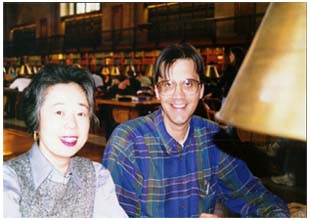

|
Haiku
for the Heartland [FEB.
1, 2000] It
may seem unlikely that a Lincoln dentist keeps winning international
prizes for poetry written in a 300-year-old Japanese form, but to
Dr. Lee Gurga it is all very natural. |
|
|
Gurga’s
interest in haiku began in 1966, when he discovered a copy of
translations of Japanese haiku in a Chicago bookshop.
A native of Chicago, he had enjoyed the poetry he studied in
high school. But haiku
made an immediate impression—it was love at first reading. After
this “discovery,” Gurga read and wrote haiku in isolation until
the mid-1980s, when he found other poets who were interested in the
form. Gurga’s
skill in blending the elements of the Japanese haiku with the
Midwestern experience has brought him recognition in the United
States, Canada, Great Britain and even Japan.
Reviewers and editors have called him a major figure among
American haiku poets and praised him for capturing the essence of
the Midwestern landscape. A
poem with a distinct heartland flavor won the grand prize in the
Kusamakura International Haiku Contest in 1996: rows
of corn stretch
to the horizon . . . sun
on the thunderhead This
haiku appeared in his 1997 volume, In
& Out of Fog, published by Press Here, Foster City,
California. The book
itself won first place in the Haiku Society of America’s National
Book Award in 1998. His latest volume, Fresh
Scent: Selected Haiku of Lee Gurga, published by Brooks Books,
Decatur, was the Haiku Society’s first place winner in 1999.
[ Left: Emiko Miyashita, Co-Translator of over 320 Haiku poems; Right: Dr. Lee Gurga ] Most
haiku have a reference to nature, Gurga says.
In fact, his own definition of haiku is this: “A short poem
that uses images of nature or the seasons to present an intuitive
and emotional complex in an instant of time.”
That instant of time is sometimes called “the haiku
moment.” Any reader who picks up a book by Gurga does not have to sit and puzzle out a poem’s meaning for Gurga believes that haiku should be accessible to the ordinary reader. In fact, he sees haiku as the world’s most accessible literary form. “It
is poetry written by people in all walks of life for a popular
audience. It is not
poetry written by professional poets for an elite audience,” he
says. A poem from
Fresh Scent illustrates
this, using an image almost all readers have seen. a
bike in the grass
one wheel slowly
turning--
summer afternoon Haiku
was unknown in the United States until after World War II, but soon
grew in popularity. The
Haiku Society of America was founded in 1968 and publication of the
first anthology of haiku in the United States came in 1974. Because
haiku began as an introduction to a longer poem, there is an
inconclusive element about it for the reader often “finishes”
the poem. Therefore,
Gurga contends that “there are two arts to haiku—writing it and
reading it.”
|
Although
the traditional Japanese haiku has seventeen syllables, often in a
5-7-5 ratio, such exact syllable count is not relevant for English
haiku, Gurga concludes, because of the structural differences in the
two languages. In
English the number of syllables can vary, depending on the content.
[ Dr. Lee Gurga ] (Picture credit: Howard Kilby) In
terms of reading haiku, Gurga states that it is different from
Western poetry. “The Western poet presents you with something and
then tells you what he thinks about it.
Haiku presents something the poet found significant and then
lets the reader find that significance.
Haiku focuses on the world around you, not on your internal
state.” Gurga himself confesses that he often finds his
inspiration while walking his dog, Fay, through the woods and prairie
on his property.
fresh scent--
the
labrador’s muzzle
deeper into snow It
is no surprise that Gurga has a long and impressive list of awards
and publications, including a 1998 Illinois Arts Council Poetry
Fellowship. In
addition, he has won first place in haiku contests in North America
and Japan. His work
appears in at least fifteen anthologies and he has given lectures in
California, Washington, D.C., Great Britain and Tokyo. Gurga
published his first volume, a
mouse pours out, in 1988, his second, The
Measure of Emptiness, in 1991, a third, dogs
barking, in 1996 and Nine
Haiku in 1997. He now serves as associate editor of the Journal
of Modern Haiku, the oldest journal of Haiku studies in the United
States. He is also listed in the Directory of American Poets and
Writers of Literature and is one of the organizers of the Global
Haiku Festival to be held April 14 through 16 at Millikin University
in Decatur. The
inspiration Gurga receives from being an integral part of the haiku
community makes him want to inspire others as well. Gurga sees
America today as lacking the interest in poetry that exists in
Japan. “A hundred
years ago, poetry was part of life in the United States.
Almost all newspapers and magazines printed poetry, often
written by people in the community. Japanese papers and magazines still do,” he says.
As
a result, he encourages the growing interest in haiku and would like
to see more appreciation of poetry in America.
“The art of making haiku has enriched my daily life,” he
says, “and I think poetry could enrich the daily lives of
others.” Editor’s
note: Gurga and his wife Jan live in rural Lincoln with their
three sons, Ben, 18, A.J., 16 and Alex, 11.
The Gurgas came to Lincoln twenty years ago because they
thought Central Illinois would be a good place to raise a family,
and because Lincoln had an opening for a dentist.
At present he practices at the Apple Dental Center at 415
Pekin Street in Lincoln and at 105 East Main Street in
Williamsville. Gurga’s
latest book, Fresh Scent,
is available at Prairie Years in downtown Lincoln.
|

